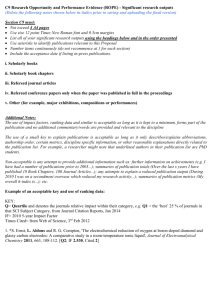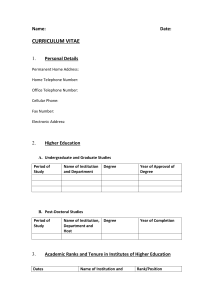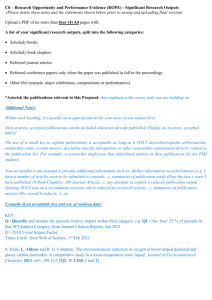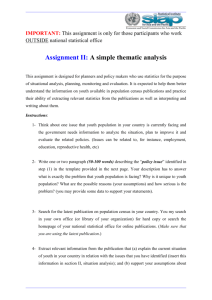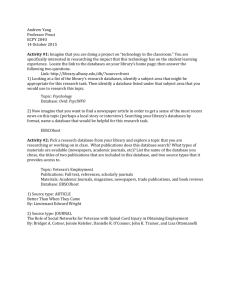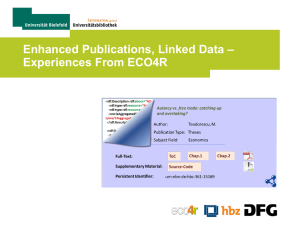478-1578-1-PB
advertisement
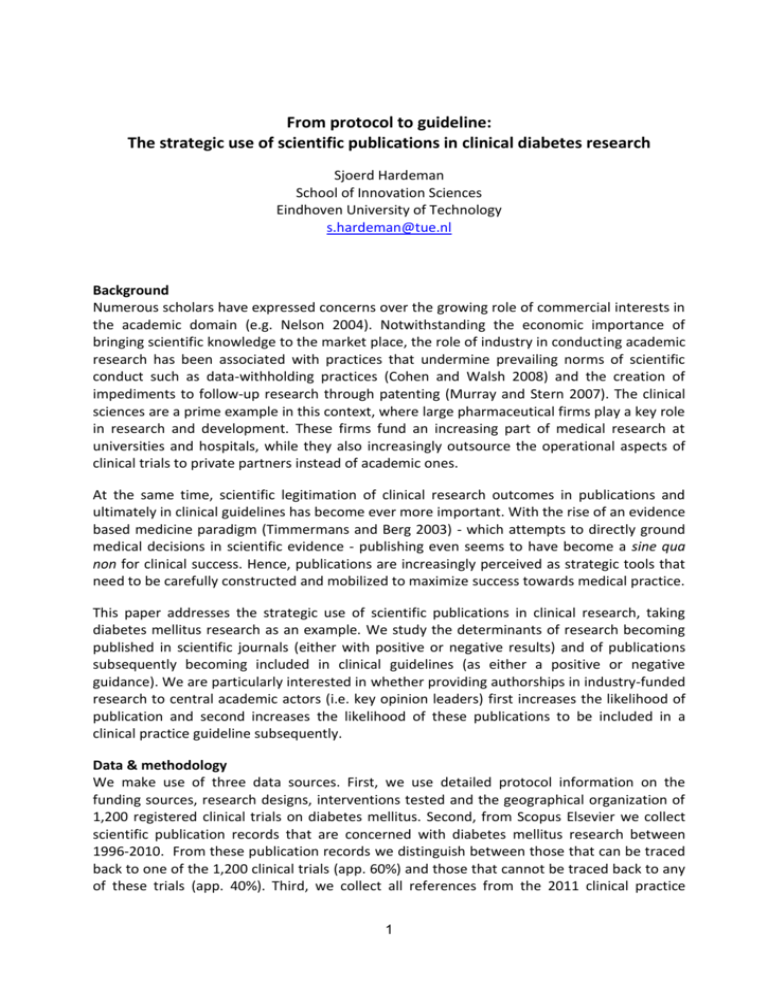
From protocol to guideline: The strategic use of scientific publications in clinical diabetes research Sjoerd Hardeman School of Innovation Sciences Eindhoven University of Technology s.hardeman@tue.nl Background Numerous scholars have expressed concerns over the growing role of commercial interests in the academic domain (e.g. Nelson 2004). Notwithstanding the economic importance of bringing scientific knowledge to the market place, the role of industry in conducting academic research has been associated with practices that undermine prevailing norms of scientific conduct such as data-withholding practices (Cohen and Walsh 2008) and the creation of impediments to follow-up research through patenting (Murray and Stern 2007). The clinical sciences are a prime example in this context, where large pharmaceutical firms play a key role in research and development. These firms fund an increasing part of medical research at universities and hospitals, while they also increasingly outsource the operational aspects of clinical trials to private partners instead of academic ones. At the same time, scientific legitimation of clinical research outcomes in publications and ultimately in clinical guidelines has become ever more important. With the rise of an evidence based medicine paradigm (Timmermans and Berg 2003) - which attempts to directly ground medical decisions in scientific evidence - publishing even seems to have become a sine qua non for clinical success. Hence, publications are increasingly perceived as strategic tools that need to be carefully constructed and mobilized to maximize success towards medical practice. This paper addresses the strategic use of scientific publications in clinical research, taking diabetes mellitus research as an example. We study the determinants of research becoming published in scientific journals (either with positive or negative results) and of publications subsequently becoming included in clinical guidelines (as either a positive or negative guidance). We are particularly interested in whether providing authorships in industry-funded research to central academic actors (i.e. key opinion leaders) first increases the likelihood of publication and second increases the likelihood of these publications to be included in a clinical practice guideline subsequently. Data & methodology We make use of three data sources. First, we use detailed protocol information on the funding sources, research designs, interventions tested and the geographical organization of 1,200 registered clinical trials on diabetes mellitus. Second, from Scopus Elsevier we collect scientific publication records that are concerned with diabetes mellitus research between 1996-2010. From these publication records we distinguish between those that can be traced back to one of the 1,200 clinical trials (app. 60%) and those that cannot be traced back to any of these trials (app. 40%). Third, we collect all references from the 2011 clinical practice 1 guideline “Standards of medical care in diabetes” of the American Diabetes Association. In all, we thus establish a link between the protocols and the guideline citation of scientific publications that are both registered and cited. The starting point for the empirical strategy is the stylized fact of publication bias, which states that industry-funded clinical trials reveal lower publication rates and convey more often positive results (Dwan et al. 2008). We replicate and extend this finding, by showing that both the likelihood of protocols becoming published in the first place and becoming published with positive results depend – next to funding source – on research design, the phase of drug development, disease complications being targeted and the countries where human subjects are recruited. For the sample of clinical trials that eventually become published, we estimate the determinants of becoming included in a clinical guideline with positive guidance, while controlling for initial organization of the clinical trial research as reflected by the protocol registration and the scientific impact of the publication as proxied by number of scientific citations. Our main hypotheses hold that in the manifestation of the publication as visible through the provision of authorships there is a positive relationship between network centrality of academic actors that appear as authors on industry-funded publications and the likelihood of subsequent positive citation of these publications in a clinical practice guideline. Preliminary results & interpretation The initial results suggest that industry funded research is often strategically positioned in the scientific literature to maximize clinical success as reflected by positive citation in clinical practice guidelines. First, for industry funded research the constitution of clinical trial publications as visible through the provision of authorships differs markedly from those mentioned on the clinical trial protocols. Second, industry funded research is much more likely to become published once central academic actors appear as authors on these publications. Finally, while controlling for the initial organization of clinical trial research as reflected by their protocols, publications positively cited in clinical practice guidelines also make much more often use of central academic actors. In all these results cast major doubts on the promises of evidence based medicine to ground medical practice in objectified and disinterested science. References Cohen, W.M., Walsh, J.P. (2007) Real impediments to academic biomedical research. Innovation Policy and the Economy, 8, 1-30. Dwan, K., Altman, D.G., Arnaiz, J.A., Bloom, J., Chan, A-W., Cronin, E., Decullier, E., Easterbrook, P.J., von Elm, E., Gamble, C., Ghersi, D., Ioannidis, J.P.A., Simes, J., Williamson, P.A. (2008) Systematic review of the empirical evidence of study publication bias and outcome reporting bias. Plos One, 3, 8, e3081. Murray, F., Stern, S. (2007) Do formal intellectual property rights hinder the free flow of scientific knowledge? An empirical test of the anti-commons hypothesis. Journal of Economic Behaviour and Organization, 63, 648-687. Nelson, R. (2004) The market economy, and the scientific commons. Research Policy, 33, 455-471. Timmermans, S., Berg, M. (2003) The gold standard: the challenge of evidence-based medicine and standardization in health care. Philadelphia: Temple University Press. 2
